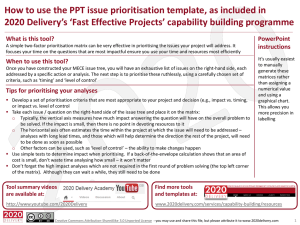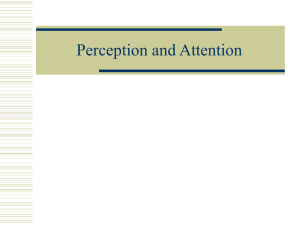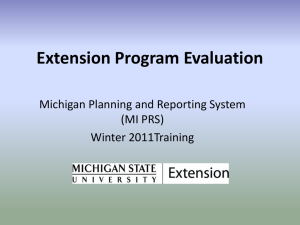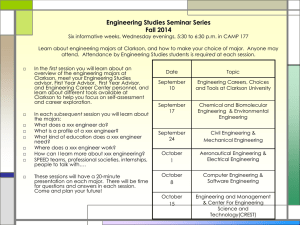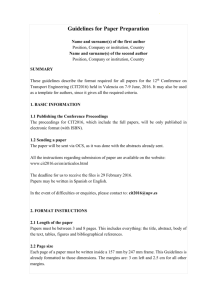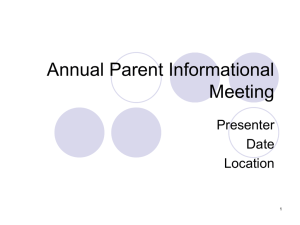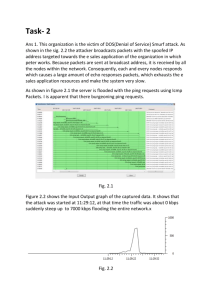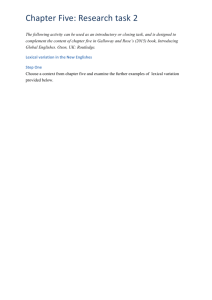Word - isfnt-12
advertisement
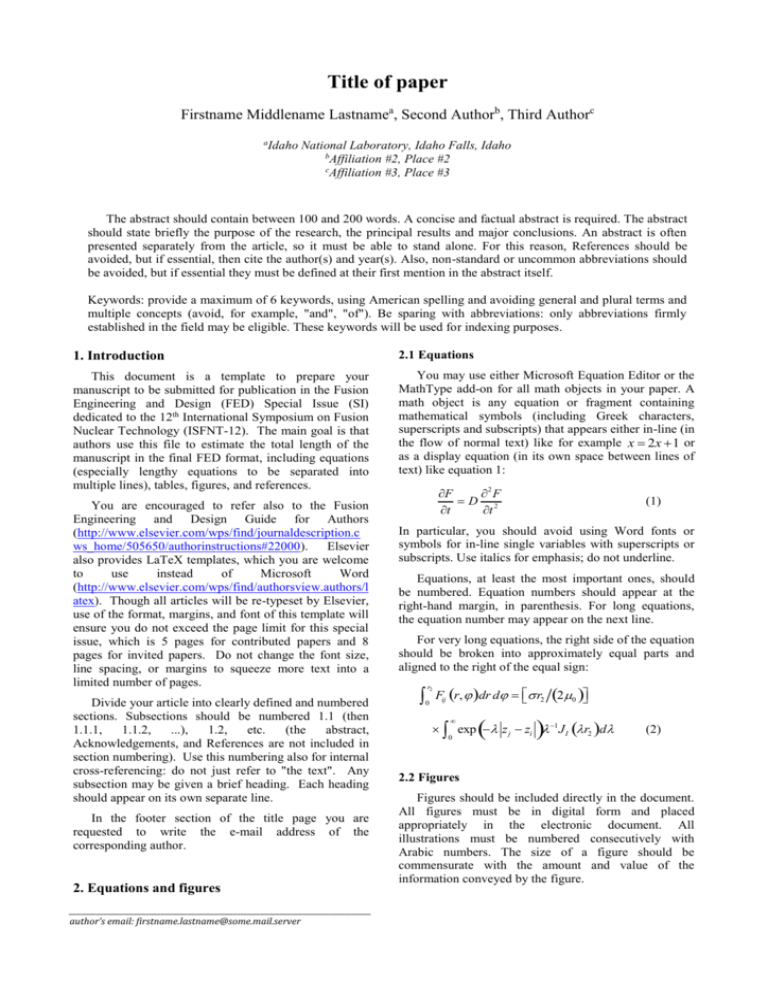
Title of paper Firstname Middlename Lastnamea, Second Authorb, Third Authorc a Idaho National Laboratory, Idaho Falls, Idaho b Affiliation #2, Place #2 c Affiliation #3, Place #3 The abstract should contain between 100 and 200 words. A concise and factual abstract is required. The abstract should state briefly the purpose of the research, the principal results and major conclusions. An abstract is often presented separately from the article, so it must be able to stand alone. For this reason, References should be avoided, but if essential, then cite the author(s) and year(s). Also, non-standard or uncommon abbreviations should be avoided, but if essential they must be defined at their first mention in the abstract itself. Keywords: provide a maximum of 6 keywords, using American spelling and avoiding general and plural terms and multiple concepts (avoid, for example, "and", "of"). Be sparing with abbreviations: only abbreviations firmly established in the field may be eligible. These keywords will be used for indexing purposes. 1. Introduction 2.1 Equations This document is a template to prepare your manuscript to be submitted for publication in the Fusion Engineering and Design (FED) Special Issue (SI) dedicated to the 12th International Symposium on Fusion Nuclear Technology (ISFNT-12). The main goal is that authors use this file to estimate the total length of the manuscript in the final FED format, including equations (especially lengthy equations to be separated into multiple lines), tables, figures, and references. You may use either Microsoft Equation Editor or the MathType add-on for all math objects in your paper. A math object is any equation or fragment containing mathematical symbols (including Greek characters, superscripts and subscripts) that appears either in-line (in the flow of normal text) like for example x 2x 1 or as a display equation (in its own space between lines of text) like equation 1: You are encouraged to refer also to the Fusion Engineering and Design Guide for Authors (http://www.elsevier.com/wps/find/journaldescription.c ws_home/505650/authorinstructions#22000). Elsevier also provides LaTeX templates, which you are welcome to use instead of Microsoft Word (http://www.elsevier.com/wps/find/authorsview.authors/l atex). Though all articles will be re-typeset by Elsevier, use of the format, margins, and font of this template will ensure you do not exceed the page limit for this special issue, which is 5 pages for contributed papers and 8 pages for invited papers. Do not change the font size, line spacing, or margins to squeeze more text into a limited number of pages. Divide your article into clearly defined and numbered sections. Subsections should be numbered 1.1 (then 1.1.1, 1.1.2, ...), 1.2, etc. (the abstract, Acknowledgements, and References are not included in section numbering). Use this numbering also for internal cross-referencing: do not just refer to "the text". Any subsection may be given a brief heading. Each heading should appear on its own separate line. In the footer section of the title page you are requested to write the e-mail address of the corresponding author. 2. Equations and figures _______________________________________________________________________________ author’s email: firstname.lastname@some.mail.server F 2 F D 2 t t (1) In particular, you should avoid using Word fonts or symbols for in-line single variables with superscripts or subscripts. Use italics for emphasis; do not underline. Equations, at least the most important ones, should be numbered. Equation numbers should appear at the right-hand margin, in parenthesis. For long equations, the equation number may appear on the next line. For very long equations, the right side of the equation should be broken into approximately equal parts and aligned to the right of the equal sign: r2 0 Fij r, dr d r2 2 0 exp z j zi 1 J I r2 d 0 (2) 2.2 Figures Figures should be included directly in the document. All figures must be in digital form and placed appropriately in the electronic document. All illustrations must be numbered consecutively with Arabic numbers. The size of a figure should be commensurate with the amount and value of the information conveyed by the figure. Place the figure caption below the figure. The abbreviation “Fig.” for figure should appear first followed by the figure number. See figure 1 for an example. For more detailed information in preparing your figures for publication on FED please refer to the Guide For Authors and information therein. Fig. 1. Example of a figure spanning two columns. Acknowledgments Collate acknowledgements in a separate section at the end of the article before the references and do not, therefore, include them on the title page, as a footnote to the title or otherwise. List here those individuals who provided help during the research (e.g., providing language help, writing assistance or proof reading the article, etc.). Do not number this section. References Fig. 2. Example a one-column figure. 3. Tables Number tables consecutively in accordance with their appearance in the text. Place footnotes to tables below the table body and indicate them with superscript lowercase letters. Avoid vertical rules. Be sparing in the use of tables and ensure that the data presented in tables do not duplicate results described elsewhere in the article. Place table captions above the table. See table 1 for an example. Table 1. Example table. Xxxxx Xxxxx X XX XXX XXXX XXX XXXX XXX X XXX X XX X XX XXX Xxxxx XX X X XX Xxxxx XXX X XXX XX XXX XX XXX Xxxxx xxxx XX XXX X XXX X XXXX All publications cited in the text should be presented in a list of references following the text of the manuscript and preceded by the word “References”. Do not number this section. In the text, indicate references by number(s) in square brackets in line with the text. The actual authors can be referred to, but the reference number(s) must always be given. Example: “Anderl and Moore [8] obtained a completely different result .....” Reference numbers should precede a comma or period [2]. Two references [3,4], should be included together, separated by a comma, while three or more consecutive references should be indicated by the bounding numbers and a dash [1-4]. In the references list, number the references (numbers in square brackets) in the order in which they appear in the text. Please ensure that every reference cited in the text is also present in the reference list (and vice versa). Any references cited in the abstract must be given in full. Unpublished results and personal communications are not recommended in the reference list, but may be mentioned in the text. If these references are included in the reference list they should follow the standard reference style of the journal and should include a substitution of the publication date with either "Unpublished results" or "Personal communication". Citation of a reference as "in press" implies that the item has been accepted for publication. [1] [2] [3] T. Pinna and L.C. Cadwallader, Component Failure rate data base for fusion applications, Fusion Engineering and Design 51-52 (2000) 579-585. R. Anderl et al., Hydrogen isotope retention in beryllium for tokamak plasma-facing applications, Journal of Nuclear Materials 273 (1) (1999) 1-26. J. Crank, The Mathematics of Diffusion, Clarendon Press, Oxford, 1975.
